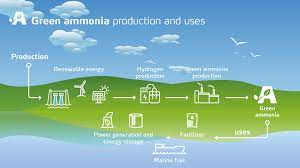
by Bill Schlesinger
It is not often that environmental scientists get to weigh-in on a new technology before it is implemented. Usually we end up complaining about the aftermath. But, there is a new suggestion on the horizon—using ammonia as a liquid fuel—that demands our attention.
When ammonia is burned, the products are nitrogen gas and water, so it avoids the greenhouse effects associated with carbon dioxide and methane. It can also be “cracked” (split apart) to form nitrogen gas and hydrogen, with the latter burned as a fuel. It is likely that ammonia would be most useful as a substitute for liquid fuels—oil and natural gas—greatly important to transportation.
Nearly all ammonia today is produced by burning natural gas in a reaction that combines nitrogen and hydrogen under high temperature and pressure. Of course, natural gas emits carbon dioxide, so unless ammonia is produced by some means that captures the CO2 emissions, it will not be without an effect on climate change. This could be accomplished with carbon capture and storage (CCS), or by using nuclear or solar power to drive the reaction. No one should be promoting ammonia fuels unless the carbon dioxide emissions problem is in hand.
Ammonia has a couple of other disadvantages. First, it is rather corrosive to metals, which curtailed its early widespread use as a refrigerant gas. Second, even modest leak rates of ammonia gas could exacerbate the already ubiquitous problems of excessive reactive nitrogen in the environment, largely from its use in fertilizers. Ammonia has serious effects of human health by forming PM2.5 particulate air pollution and polluting waters where it is deposited inadvertently. An ammonia economy with a 2.5% leak rate—typical of natural gas—could add 50% to the amount currently produced for fertilizers.
A byproduct of ammonia combustion is nitrous-oxide (N2O), which is a potent greenhouse gas (>200 X CO2) and a precursor to ozone destruction in the stratosphere. Adopting ammonia as a transportation fuel could triple the current anthropogenic emissions of nitrous oxide to the atmosphere.
Some of these problems can be addressed with proper attention to minimizing leaks in the production and distribution of ammonia and by engineering the optimal temperature for ammonia combustion, perhaps in a mix with other fuels. In any case, we have some work to do.
References:
Bertagni, M.B. and 11 others. 2023. Minimizing the impacts of the ammonia economy on the nitrogen cycle and climate. Proceedings of the National Academy of Sciences 120: doi: 10.1073/pnas.2311728120
Chai, W.S., Y.L. Bao, P.F. Jin, G. Tang, and L. Zhou. 2021. A review on ammonia, ammonia-hydrogen, and ammonia-methane fuels. Renewable and Sustainable Energy Reviews 147: doi: 10.1016/j.rser.2021.111254
Wolfram,P., P. Kyle, X. Zhang, S. Gkantonas, and S. Smith. 2022. Using ammonia as a shipping fuel could disturb the nitrogen cycle. Nature Energy 7: 1112–1114.